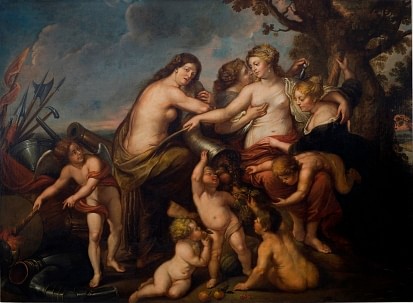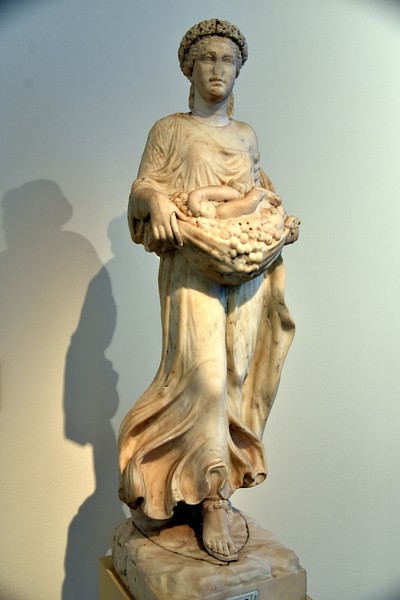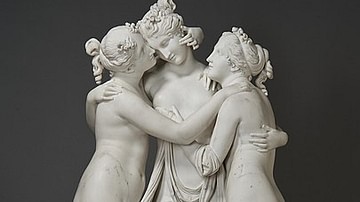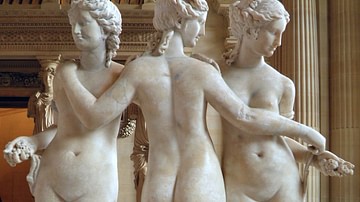
The Horae (Horai, sing. Hora) were the personification and goddesses of the seasons and the hours and, later on, were regarded as goddesses of order and justice in Greek mythology. They were the daughters of Zeus and the Titaness Themis and were usually three in number. However, their names and numbers differ depending on the source.
They were closely associated with the Graces, the Fates, and the goddess Aphrodite and guarded the gates of Olympus. They were considered benevolent and kind, often bringing good things to the gods and humankind, and were connected to everything good and beautiful in nature. In art, they were often depicted as beautiful maidens in threes, carrying produce from different seasons. The English word 'hour' is derived from the Greek and Latin hora.
Parentage & Names
As mentioned by Hesiod (c. 700 BCE) in his Theogony, the Horae were the daughters of Zeus and the Titaness Themis:
And shining Themis was his second wife.
She bore the Horae: Order, blooming Peace,
And Justice, who attend the works of men.(Hesiod, Theogony, 900-903).
Depending on the source, the names and number of the Horae differ, although most sources, including Hesiod, Pseudo-Apollodorus (c. 1st or 2nd century CE), and The Orphic Hymns list the Horae as being named Eunomia (Lawfulness), Eirene or Irene (Peace), and Dike or Dice (Justice). Other authors, including Pausanias (c. 115 to c. 180 CE) and Pseudo-Hyginus (Gaius Julius Hyginus) (c. 64 BCE to 17 CE), gave their names as Carpo (Fruit), Auxo (Growth), and Thallo (Blooming) or Europia (Abundance), Pherusa (Substance), and Orthosie (Prosperity).
Goddesses of the Seasons
As the personification and goddesses of the seasons, the Horae were considered the giver of seasons (especially of Spring and Autumn). Homer (c. 750 BCE) referred to them as the Olympian deities of the weather. Three Horae are specifically linked with the seasons: Thallo (the Hora of Spring), Carpo (the Hora of Autumn), and Auxo (the Hora of Summer). The courses of the seasons were symbolically described by the dance of the Horae accompanied by the singing of the Muses and the lyre-playing of Apollo.
The Hora of Spring (Thallo) accompanied Persephone on her annual journey from the underworld to Earth, which symbolised the coming of spring. The Hora of Spring carried flowers, while Summer held corn, and Autumn was laden with grapes and other fruits. Flowers, freshness, and fragrance were associated with the Horae, and even inanimate objects took on a charm of their own, thanks to the Horae. As they promoted the health and prosperity of everything that grew, they adopted the role of protectress of the youth and newly-born gods. They caused fruit and flowers to grow after they showered them with their life-giving streams.
In Ovid's (43 BCE to 17 CE) Metamorphoses, Helios (Phoebus) sat on a throne of emeralds surrounded by the personification of the Day, Month, and Year, as well as the Horaes (Hours), and Spring with flowers, Summer with an ear of corn, Autumn with the juice of grapes and aged Winter.
Interestingly enough, the number of Horae representing the seasons originally ranged from two to three in most classical sources instead of the expected four. This is because the ancient Greeks mainly recognised spring, summer, and autumn as the proper seasons, while winter was viewed as a time of sleep and death. Only later on did the Hora representing winter become accepted.
Goddesses of Order & Justice
In later times, the Horae were also viewed as the goddesses of order and justice with the influence they had on the seasons and nature being transferred to human life. Hesiod described them as providing peace, justice, and good laws to a state and named them the appropriate Eunomia (Lawfulness and Good Order), Dike (Justice), and Eirene (Peace) – a direct connection to the concepts of the natural order. Each Hora had a specific function: Eunomia looked after state life; Dike protected the interests of humankind, and Eirene, the most lighthearted of the three, ensured that there was peace on earth.
Justice is dragged out of the way by men
Who judge dishonestly and swallow bribes,
A struggling sound is heard; then she returns
Back to the city and the homes of men,
Rapped in a mist and weeping, and she brings
Harm to the crooked men who drove her out.
But when the judges of a town are fair
To foreigner and citizen alike,
Their city prospers and her people bloom;
Since Peace is in the land, her children thrive;
Zeus never marks them out for cruel war.(Hesiod, Works and Days, 221-233).
Just as the different seasons required some order, the Horae provided order and justice to civilised communities.
Guardians of the Heavens & Time
The Horae stood at the gates to Olympus and admitted those who had the right to enter, welcoming back gods from a heroic mission or task. They also saw off the gods as they left the palace. As mentioned in Homer's Iliad, the Horae let Hera in the groaning gates of Olympus. When they opened the gates, it revealed a dense darkness.
They also presided over the divisions of time. Every morning, they fastened the celestial horses to the magnificent chariot of Helios and unyoked them after the sun had retreated to rest.
Nurses & Attendants of the Gods
Ancient writers Menander (c. 342-291 BCE) and Alcaeus of Mytilene (c. 620 BCE) state that the Horae were nurses, with Philostratus the Elder (c. 170-247/250 CE) writing that they nursed the baby Hermes. Pausanias also mentions that the Horae raised Hera.
In the Homeric Hymn to Aphrodite, after Aphrodite was born, the Horae welcomed her, clothed her in ambrosial garments, crowned her in gold, and placed copper and gold jewellery in her ears and around her neck – the same jewellery the Horae wore whenever they went to their father's house. They then led Aphrodite to the gods, who had gathered to welcome Aphrodite and admire her beauty. In the Homeric Hymn to Pythian Apollo, the Graces and cheerful Horae dance with Aphrodite, Hebe, and Harmonia, holding each other by the wrist.
The Orphic Hymn to the Horae and the Orphic Hymn to Persephone describe the Horae as being companions to Persephone. Along with the Fates, and Graces, they led her back up to the light of spring from the underworld, where they then formed a solemn dance. They are also companions to the rustic god Pan, according to the Orphic Hymn to Pan. The Horae made a crown for Pandora out of spring flowers. At her wedding, Ariadne gave Theseus a wreath that had initially been a gift from the Horae.
In Nonnus' Dionysiaca, the Horae became the midwives of Dionysos. After Dionysos was born from Zeus' thigh, the Horae crowned him with an ivy garland. The role of nurse and attendant to the gods was a somewhat surprising role for the Horae, as the role of nurses was usually delegated to the lower class and not traditionally given to the immortals. It shows the relatively low ranking of the Horae in regard to the other deities.
The Horae, the Graces & the Fates
The Horae have long been associated with the other triads of goddesses that are found in Greek mythology: the Graces (the Charites), goddesses who were responsible for bestowing beauty upon the world, and the Fates (the Moirai), who control a person's lifespan. Although these groups of goddesses are relatively minor figures compared to the other, more prominent deities, they influence characters, events, fate, luck, and the weather. They often have significant interactions with different gods and goddesses. Their actions are repeated over seasons and the cycle of life and death.
Worship
The Horae had an Orphic Hymn dedicated to them.
Seasons, daughters of Themis,
daughters of Lord Zeus,
Eunomia and Dike
And thrice-blessed Eirene,
pure spirits of Spring,
of blossoming meadows,
you are found in every colour, in all scents
wafted by the breezes.
Ever-blooming, revolving, and sweet-faced,
O Seasons,
you cloak yourselves with the dew
of luxuriant flowers.
At play you are companions
Of holy Persephone, when the Fates
and the Graces in circling dances
come forth to the light,
Pleasing Zeus
and their mother, giver of fruits.
Come to the new initiates
and their holy and reverent rites,
bring perfect seasons
for the growth of goodly fruit.(The Orphic Hymns: To the Seasons, 43.1-10)
In the Description of Greece, Pausanias writes that the Horae were worshipped in Corinth, where a sanctuary to them could be found. Sculptures of the Seasons by the sculptor Endoios were found at the entrance to the Shrine of Athena in Achaia (Achaea). There were cults to the Seasons located in Athens. In Lakonia (Laconia), sculptures of two Horae stood alongside two Graces in front of a throne. They are also represented on an altar along with other gods and goddesses from Greek mythology.
In Hera's temple in Olympia, a sculpture of the Seasons by Smilis of Aigina stood next to statues of Zeus and Hera, who were seated on thrones. Their mother, Themis, stood alongside them. There was also an altar dedicated to the Seasons located in Olympia. Another one of Hera's temples near Mycenae featured a statue of the goddess wearing a crown that was adorned with the Seasons and the Graces.











